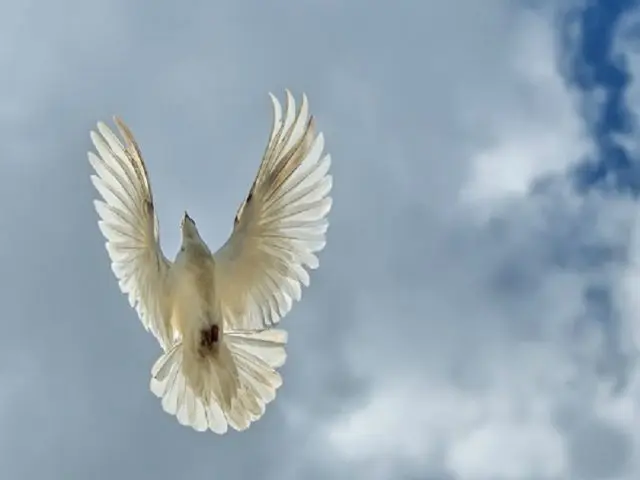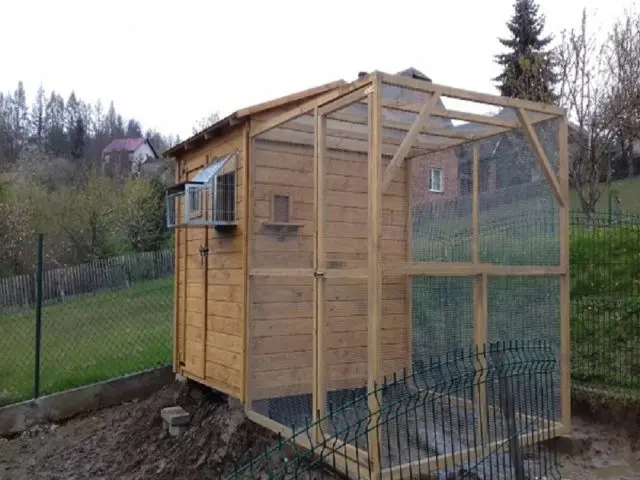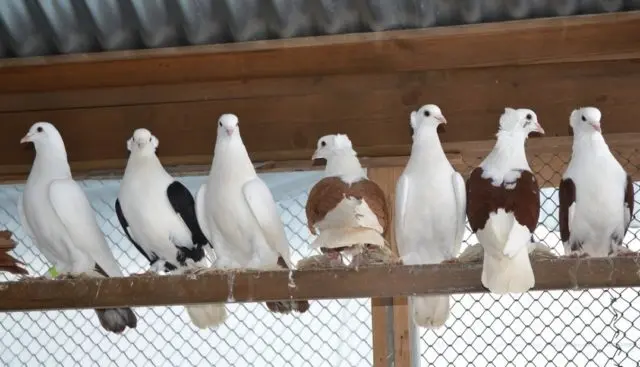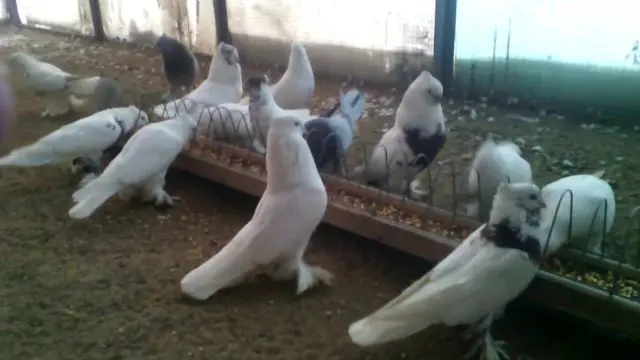Contents
Andijan pigeons are especially popular with breeders. And this is not surprising. Thanks to their flight characteristics and beautiful appearance, birds take pride of place in sports competitions and exhibitions. However, the breed requires certain conditions of maintenance and care.

History of Andijan pigeons
The history of the appearance of Andijan pigeons begins at the end of the 19th century. According to historical information, one of the inhabitants of Iran moved to the city of Andijan, which is located on the territory of Uzbekistan. The Iranian brought pigeons along with his belongings. The birds amazed local poultry farmers with their ability to make long flights. But they did not have exterior indicators. In order to combine these two qualities, the breeders decided to cross these individuals and the local Ischilean breed. This is how Andijan pigeons appeared.
Breeders successfully coped with the task. The breed has an attractive appearance and a long, beautiful flight. Therefore, Andijan pigeons quickly spread throughout Uzbekistan.
As a result of interethnic events, from 1989 to 2010, Asian residents began to migrate to European countries. The settlers, along with their acquired property, took local pigeons with them. So the Andijan breed came to the CIS countries and to the territory of Europe.
Breed signs and standards
There is a breed standard for Andijan pigeons. It characterizes the main features, constitution, exterior and behavioral qualities of birds. Deviations from the stated requirements of world poultry organizations indicate the shortcomings and defects of the breed.
Appearance Description
Andijan pigeons have a fairly strong body. The average weight of birds is 320 g. Although there have been cases when this value reached 400 g. The body length varies from 35 to 40 cm. The girth of the body is 27 cm. The wingspan is 70 cm. The length of the feather is 10 cm.
External signs of the Andijan breed:
- body – long, muscular, slightly raised up;
- chest – wide, well developed;
- tail – long, straight, with 12-14 tail feathers;
- wings – strong, with a snug fit to the body;
- neck – dense, with a smooth transition to the chest;
- head – oval, medium size;
- eyes – large, white or silver, with a milky iris;
- the beak is neat, strong, its color is combined with the shade of the head;
- forelock – long, narrow, slightly oblique, located at the back of the head;
- legs – erect, with a small amount of feathers in the lower limb;
- paws – with spurs and sharp nails.
In total there are more than 60 species of Andijan pigeons. Therefore, individuals do not have strict color standards.

Andijans can be pure white, or with brown or black patches in the neck. Red, brown and gray-lilac outflow of feathers is also allowed.
Character
Andijan pigeons have a calm and peaceful character. They do not establish a hierarchy in the herd and do not conflict with other birds. But at the same time, pigeons are strong enough, hardy, mobile and energetic. They adapt to any situations, and also anticipate the nearest development of events.
As for fidelity, Andijan pigeons are tied to the owner. Even if the birds are tired or lost in flight, they will not sit on someone else’s roof.
Parental instinct
Andijan pigeons have good parental instincts. They create the necessary conditions for the development of pigeons and rarely abandon them. Birds incubate, feed and protect offspring without human intervention.
At the same time, birds do not have a separation between male and female. All actions are performed jointly.
Flight characteristics
Andijan pigeons are high-flying fighting birds. Their movement through the air is distinguished not only by a peculiar style, but also by flight qualities.
Birds are able to overcome several hundred kilometers and soar up more than 20 meters. Their flight time is from 4 to 6 hours. Some specimens manage to spend more than 10 hours in the sky.
Andijan individuals are well oriented in the air. During the rise in height, the birds stay in flocks and carry out “exit to the pole”. That is, they are in a stationary state for several minutes.

During the flight, pigeons can perform all kinds of somersaults for a long time. When they are executed, a characteristic click is emitted. In poultry circles, this sound is usually called – “battle”. Where did the name come from – fighting.
Keeping Andijan pigeons
According to poultry farmers, Andijan is a whimsical breed. Without certain conditions of detention, the aesthetic and flying qualities of birds deteriorate. Various diseases develop that adversely affect offspring.
Place of choice for the poultry house
There are a number of specific requirements regarding the location of the dovecote:
- The poultry house should not be installed next to multi-storey buildings and tall trees. It will be difficult for Andijan residents to take off and land.
- The dovecote should be kept away from electrical wires and telephone lines. Otherwise, individuals will increase the risk of injury.
- The room is not recommended to be placed near cesspools or landfills. The fact is that the immunity of Andijan pigeons is poorly opposed to pathogenic microorganisms.
Requirements for the room
Pigeons of the Andijan breed cannot be kept in cages. For their breeding it is rational to build a free aviary.

The main criteria for the premises:
- Poultry dimensions. For 1 Andijan bird, the air area of the dovecote is 1,5 sq.m. Floor area – 0,5 sq.m.
- Dimensions and location of windows. The optimal dimensions of a stained-glass window are 20×20 cm. Windows should be placed in front of 1 m above the floor.
- Door size. The width of the entrance opening is 0,6 m, the height is 1 m.
- Construction material. When choosing raw materials for walls, it is recommended to give preference to wood.
Andijan pigeons do not tolerate drafts and noise. Therefore, the walls of the room will need to be sheathed with plywood, and the cracks will need to be carefully puttied.
Poultry house arrangement
In order for Andijan pigeons to feel comfortable, it will be necessary to create optimal living conditions in the poultry house.

The internal arrangement of the dovecote includes:
- Lighting. It will increase the length of daylight hours and serve as an additional source of heat. LED lamps are used as additional lighting.
- Feeders. Andijan pigeons should not be allowed to interfere with each other while eating. Therefore, devices for feeding birds are equipped with several sections.
- Drinkers. The best option for decorative pigeons is industrial drinking bowls. So the birds will always have clean and fresh water.
- Perches. It is recommended to choose wooden beams as the crossbars for resting Andijan individuals. Their thickness should correspond to the size of the paws of pigeons.
- Nests. Buildings for laying eggs and rearing offspring should have several compartments. This approach will help to keep heterosexual birds and young animals separately in winter.
Carrying out sanitary and hygienic procedures
Andijan lacks cleanliness. Therefore, without timely cleaning, the dovecote is quickly polluted, and the birds have an unsightly appearance.
Carrying out sanitary and hygienic procedures includes the following actions:
- daily bedding change;
- complete disinfection of the premises once every six months;
- airing the house 2-3 times a week;
- cleaning of feeders and drinkers 1 time in 2 days.
In addition, you will need to regularly monitor the health of Andijan birds. At the first signs of the disease, you should immediately begin appropriate therapeutic measures. Otherwise, the pathology will quickly spread throughout the flock of pigeons.
Diet
The general characteristics of Andijan pigeons directly depend on nutrition. The main ingredient of feeding is grass. In the summer, birds use it fresh. In winter, pigeons are fed hay from herbaceous plants.
The diet should also include the following crop grains:
- millet;
- oats;
- rye;
- corn;
- barley.
Andijan birds should receive from vegetables:
- boiled potatoes;
- shredded carrots.
Shell rock, fish oil, eggshell are used as natural additives.

Andijan pigeons are fed 2 times a day. Before the flight they are given small portions. Upon returning to the dovecote, the birds are pampered with rich food.
Crossbreeding
To prevent the production of non-viable offspring or chicks with various abnormal defects, natural mating of pigeons should not be allowed. To maintain breed standards, Andijan birds are crossed according to external characteristics. To do this, the breeder forcibly closes the selected pair for 12 hours in a separate cage. After this time, he releases them into the wild.
Productivity increase
Adult Andijan individuals lay two eggs. And young females are one. Laying occurs, 8-9 days after mating, with a frequency of 2 days.
Before the next egg appears, it is recommended to replace the first one with snag. This is done so that the dove does not immediately start heating it. Otherwise, the embryo will slow down in development and die.
The incubation period is 18-20 days. The chicks then hatch from the eggs.
Conclusion
On average, Andijan pigeons live 15-20 years. During this period, they do not lose their characteristic features. But breeding decorative individuals is not as easy as it might seem at first glance. Throughout the life cycle, they will need to organize optimal conditions for housing, care and care.









